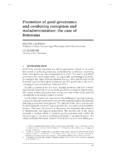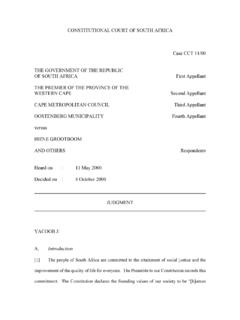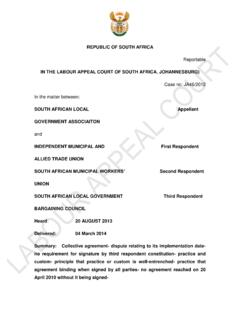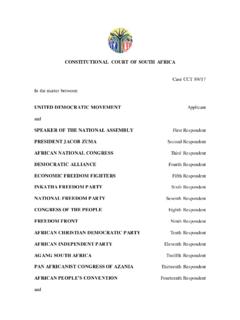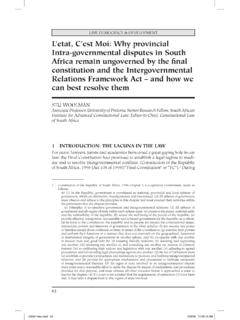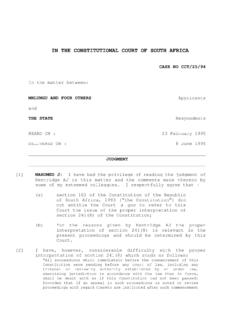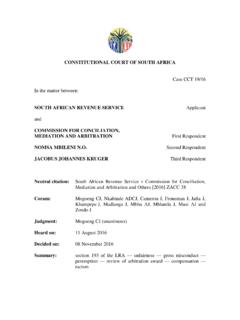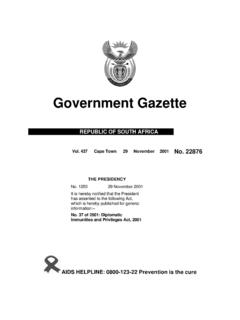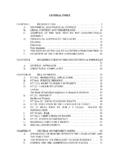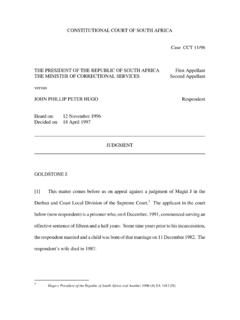Transcription of CONSTITUTIONAL COURT OF SOUTH AFRICA - …
1 CONSTITUTIONAL COURT OF SOUTH AFRICA Case CCT 53/06 [2007] ZACC 18 m * Applicant versus THE STATE Respondent CENTRE FOR CHILD LAW Amicus Curiae Heard on : 22 February 2007 Decided on : 26 September 2007 JUDGMENT SACHS J: [1] When considering whether to impose imprisonment on the primary caregiver of young children, did the courts below pay sufficient attention to the CONSTITUTIONAL provision that in all matters concerning children, the children s interests shall be paramount? Background * At the commencement of the hearing on 22 February 2007 this COURT issued an order that the citation of the case name in this matter shall be M v The State in order to protect the identity of the applicant s three minor children.
2 SACHS J [2] M is a 35 year old single mother of three boys aged 16, 12 and 8. In 1996 she was convicted of fraud and sentenced to a fine coupled with a term of imprisonment that was suspended for five years. In 1999 she was charged again with fraud, and while out on bail after having been in prison for a short period, committed further fraud. In 2002 she was convicted in the Wynberg Regional COURT on 38 counts of fraud and four counts of theft. The COURT took all the counts together for purposes of sentence. The total amount involved came to R29 158, 69. The COURT asked for a correctional supervision report. The report indicated that M would be an appropriate candidate for a correctional supervision order. Despite strong pleas from her attorney that she not be sent to prison the COURT sentenced her to four years direct [3] The Regional Magistrate refused to grant bail pending an appeal, but after M had been in jail for three months, the Cape High COURT granted leave to appeal and allowed her to be released on bail.
3 The High COURT later held that she had been wrongly convicted on a count of fraud involving an amount of R10 000, and, since this reduced the quantum of the remaining counts to R19 158, 69, converted her sentence to one of imprisonment under section 276(1)(i)2 of the Criminal Procedure 1 The order reads as follows: All the counts are taken as one for purposes of sentence and you are sentenced to: FOUR (4) YEARS IMPRISONMENT. In terms of Section 280 of the Criminal Procedure Act the COURT orders that if the suspended sentence imposed on the 24th of February 1996 is put into operation, if that is put into operation, that two years of the four years that is imposed today will run concurrently with that sentence. 2 Section 276(1) provides: (1) Subject to the provisions of this Act and any other law and of the common law, the following sentences may be passed upon a person convicted of an offence, namely.
4 2 SACHS J Act (the CPA). The effect of this change was that after she had served eight months imprisonment, the Commissioner for Correctional Services (the Commissioner) could authorise her release under correctional supervision. The COURT denied her leave to appeal against this sentence to the Supreme COURT of Appeal. [4] M then petitioned the Supreme COURT of Appeal for leave to appeal against the order of imprisonment. The Supreme COURT of Appeal turned down her request. It did not give reasons. She next applied to this COURT for leave to appeal against the refusal of the Supreme COURT of Appeal to hear her oral argument, as well as against the sentence imposed by the High COURT . [5] This COURT refused the first part of her application, namely, that she be given leave to appeal on the ground that the Supreme COURT of Appeal had given no reasons for refusing to hear oral argument.
5 It did, however, enrol her application for leave to appeal against the sentence. The directions by the Chief Justice required the parties to deal with the following issues only: I. What are the duties of the sentencing COURT in the light of section 28(2) of the Constitution and any relevant statutory provisions when the person being sentenced is the primary caregiver of minor children? II. Whether these duties were observed in this case. III. If it was to hold that these duties were not observed, what order should this COURT make, if any? (i) imprisonment from which such a person may be placed under correctional supervision in the discretion of the Commissioner or a parole board.
6 3 SACHS J The Registrar was directed to serve a copy of these directions on the Minister for Social Development and the Minister for Justice and CONSTITUTIONAL Development, who were given the opportunity to file affidavits if they wished. [6] Advocate Paschke was appointed curator ad litem. He produced a comprehensive report supported by a report compiled by a social worker, Ms Cawood. The Centre for Child Law of the University of Pretoria was admitted as amicus curiae and Ms Skelton made wide-ranging written and oral submissions on the CONSTITUTIONAL , statutory and social context in which the matter fell to be decided. [7] The applicant, the curator and the amicus all contended that the effect of section 28 of the Constitution was to require sentencing courts, as a matter of general practice, to give specific and independent consideration to the impact that a custodial sentence in respect of a primary caregiver could have on minor children.
7 On the facts of this case they argued that due consideration of the interests of M s children required that an appropriately stringent correctional supervision order should be imposed in place of a custodial sentence. [8] The National Director of Public Prosecution replied that current sentencing procedures in the courts already took account of the interests of children, and that on the facts of the case the decision of the High COURT should not be interfered with. Counsel for the Department of Social Development and the Department of Justice and 4 SACHS J CONSTITUTIONAL Development adopted a similar position, submitting a comprehensive report from a team of social workers to assist the COURT . [9] We are grateful to all the above persons for the careful and methodical manner in which they undertook their tasks.
8 In matters concerning children it is important that courts be furnished with the best quality of information that can reasonably be obtained in the circumstances. The extensive information and thoughtful arguments advanced by all the above-mentioned protagonists in this matter fully meet this standard. Aided by this most helpful material I respond in sequence to the questions as formulated in the directions. I. What are the duties of the sentencing COURT in the light of section 28(2) of the Constitution and any relevant statutory provisions when the person being sentenced is the primary caregiver of minor children? (a) The current approach to sentencing [10] Sentencing is innately However, all the parties to this matter agreed that the classic Zinn4 triad is the paradigm from which to proceed when 3 SOUTH African Law Commission Report on a New Sentencing Framework Project 82 (November, 2000) at para The report explains at para that individual decisions are announced to a critical public who analyse them against a variety of expectations.
9 They not only ask whether the sentences express public condemnation of the crime adequately and protect the public against future crimes by the reform and incapacitation of offenders and by the deterrence of both the individual offender and other potential offenders, but also whether the sentences are just in the sense that similar sentences are being imposed for offences that are of equal seriousness or heinousness. In addition there is a growing expectation that the sentence must be restorative, in the sense both of compensating the individual who suffered as the result of a crime and of repairing the social fabric that criminal conduct damages. All these concerns are inevitably particularly prominent amongst victims of crime, who have a special interest in the offences that they themselves have suffered.
10 5 SACHS J embarking on the lonely and onerous task 5 of passing sentence. According to the triad the nature of the crime, the personal circumstances of the criminal and the interests of the community are the relevant factors determinative of an appropriate In Banda Friedman J explained that: The elements of the triad contain an equilibrium and a tension. A COURT should, when determining sentence, strive to accomplish and arrive at a judicious counterbalance between these elements in order to ensure that one element is not unduly accentuated at the expense of and to the exclusion of the others. This is not merely a formula, nor a judicial incantation, the mere stating whereof satisfies the requirements. What is necessary is that the COURT shall consider, and try to balance evenly, the nature and circumstances of the offence, the characteristics of the offender and his circumstances and the impact of the crime on the community, its welfare and concern.
